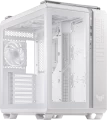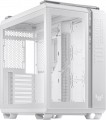Rubber feet
The presence of
rubberized legs in the design of the case.
These feet absorb vibrations generated during operation of the computer (mainly due to the operation of fans and optical drives), thereby reducing noise levels and providing additional comfort. Rubberized feet are especially desirable if the computer is placed on a table (on a tabletop or in a dedicated compartment on a table) or on a hard floor.
Side panel
— Removable panel. Opening by removing one or more panels is the most popular option in modern PC cases. This design is inexpensive, convenient and practical, and fits any form factor (see above). The specific device of such an opening system just depends primarily on the form factor, more precisely, on the overall layout of the case. So, in vertical products (one or another type of Tower), both side panels are usually removable, in horizontal “desktops” — the top panel, and in the Cube Case the options may be different.
— U-shaped cover. A solid cover of a characteristic shape — in the form of the letter "P" — covering the case simultaneously from the sides and from above. Thus, when such a cover is removed, the case is open from three sides at once. In some cases (for example, to access the top 5.25" compartment, this feature turns out to be very useful. At the same time, U-shaped covers are rather bulky, removing and putting such a part in place is noticeably more difficult than carrying out these operations with separate removable panels; this is especially true for vertical tower cases, which is why this opening mechanism is rare these days, almost exclusively in Desktop and CubeCase products.
—
Door. Another rather rare opening mechanism, in this case, typical for cases in various variations of the Tower form factor. The name quite accurately conveys the way this mechanism works: the side panel of the case is not
...removed, but opens sideways like a hinged door. The main advantage of this option is that a convenient lock is often used to fix the door in the closed position, which can be opened without special tools — for example, by pressing a button. This greatly simplifies access to the contents of the case, especially when you need to fine-tune or quickly replace individual PC components. On the other hand, the open door cannot be set aside like a removable panel, and in some situations it can be inconvenient by hanging on the case. Yes, and such a design is somewhat more expensive than the same removable elements. Therefore, doors are rarely found nowadays — mainly in separate game models of cases (see "In the direction").Fans total
The
more fans provided in the design, other things being equal, the more intense the cooling will be and the more powerful (and, accordingly, “hot”) hardware can be placed in the case without the risk of overheating. For everyday tasks, a case with
one,
two or
three factory fans is enough. At the same time, when comparing, it is worth considering not only the number, but also the performance characteristics of the fans (diameter, speed). Also note that there are
cases without fans on the market with free space for fans, which allows, if necessary, to supplement the cooling system and improve its performance.
Dust filter
The presence of a special filter in the housing to prevent dust from entering. Without such a filter, dust settles on the system elements; Radiators are especially susceptible to this; they also lose their efficiency by becoming clogged with dust. If you have
a dust filter, you have to clean not the “filling” of the PC, but the filter element itself, which is much simpler and more convenient.
Compartments for dust filters can be located on
the front panel of the case,
back,
bottom,
top, or
in the side walls. There are also case models with several technological niches for installing dust filters - the combined version assumes the presence of such compartments on several sides of the case at once.
Integrated hub
A hub in a computer case for connecting fan and backlight control systems. Depending on the implementation, the
complete hub can be installed inside the case or placed on its outer panel. Often, a remote control with an infrared transmitter is attached to the hub to control the "turntables" and decorative lighting of the "insides" of the case.
Liquid cooling (rear)
The size of the seat for the water cooling system provided on the back of the case.
In cases with CBO support, water cooling radiators are installed in the same slots as traditional fans. In other words, either a fan (fans) or a CBO radiator can be installed on the same seat. The size of the seat under the CBO is indicated by one number — the length (on the larger side); the width can be determined based on these data. The fact is that modern CBO radiators usually use fans of one of the standard sizes — 120 mm or 140 mm; and if there are several such fans, they are arranged in a row. As a result, the length of the radiator turns out to be a multiple, and the width is equal to one of these numbers: for example, 280 mm is 2x140 mm with a width of 140 mm, and 360 mm is 3x120 mm with a width of 120 mm.
Note that in this case, the same nuances are relevant as for air cooling: a larger fan takes up more space and costs more, but it is considered more advanced, as it can work efficiently at a lower speed — and this reduces the level of noise and vibration.
USB C 3.2 gen2
Number of native
USB-C 3.2 gen2(previously USB-C 3.1 gen2 and USB-C 3.1) connectors provided in the chassis.
Such connectors are usually located on the front side (for more details, see "Location"). They are most convenient for peripherals that need to be connected and disconnected often — for example, "flash drives" (for permanently connected devices, it is more convenient to use motherboard connectors that are displayed on the rear panel) . Specifically,
USB-C is a relatively new type of USB connector — smaller than classic USB and double-sided design. The use of such a connector may be different, depending on the features of the motherboard: in particular, it can also be used as a Thunderbolt v3 port, and the 3.2 gen2 connection interface is characterized by a bandwidth of up to 10 Gbps.
USB C 3.2 gen2x2
USB-C type connector supporting connection version 3.2 gen2x2. For more information about the connector itself, see above; and version 3.2 gen 2x2 (previously known as USB 3.2) allows to achieve speeds up to 20 Gbps — that is, twice as high as in the original 3.2 gen 2, hence the name. It is also worth noting that this version is implemented only through USB-C connectors and is not used in ports of earlier standards.
More features
—
Front cover. A hinged cover that completely or partially covers the front panel. Gives the computer a neat appearance, hiding connectors and external slots under a solid, uniform surface and performs the function of child protection.
—
Panel display. A display on the front or side panel of the case, used to display various service information: the current processor frequency, data on the system temperature, cooling operating mode, etc. Various important data can be displayed on the display without reference to what is happening in the software part of the computer.
—
Video card holder. A design solution for supporting a video card inside the case. Specialized stands or holders prevent the graphics adapter from sagging over time and reduce the load on the PCI-E slot of the motherboard. The fact is that many models of modern video cards have gained some weight - the holders are designed to compensate for their weight. Stands are available both as built-in solutions and as separate accessories that can be installed inside the case independently.
—
Side panel lock. The presence of a special lock on the removable side panel of the case. Such a lock prevents unauthorized access to the internal volume of the system unit.
—
Noise isolation. Availability at the case of
...additional sound insulation. This can be either a special coating on the inside, or other, more specific solutions (for example, damping systems on “seats” for individual components that reduce the level of vibrations transmitted to the body). Anyway, this feature helps to reduce the noise level emitted by the system — sometimes quite significantly.
— Removable basket for HDD. The presence in the design of the case of a removable basket for the inner periphery of the 3.5 "form factor (in the vast majority of cases these are hard drives, hence the name). Such a basket facilitates assembly due to the fact that it is much easier to remove it and install a hard drive inside than mount it in a non-removable compartment inside the case; this moment is especially useful if you plan to install several hard drives in the system.
— Docking station for HDD. Built-in docking station for quick connection of internal hard drives. In fact, this function allows you to connect an internal HDD as an external one: the docking station connector is located outside the case and is equipped with quick-release fasteners for easy connection.
— Concealed wiring. The ability to run wires from the power supply on the back of the motherboard (if we take the side where the processor and slots for expansion cards are located as the main one). Thus, the space on the main side of the "motherboard" is freed from wires, which, in particular, has a positive effect on the cooling efficiency.
— The window for installing the cooling system(Cooling system) for CPU. The presence of a separate window in the case opposite the CPU fasteners. The mounting system is located on the back of the motherboard, and usually, in order to change it, you need to remove the entire "motherboard"; the Cooling system installation window saves the user from such a need and greatly simplifies the installation and change of Cooling system.
